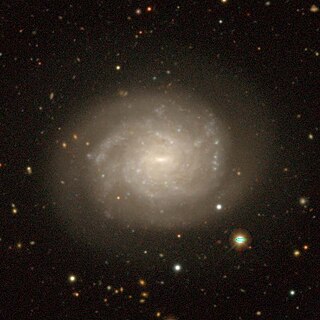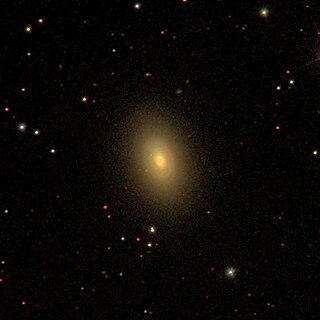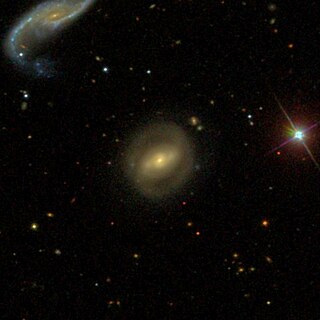
NGC 5371 is a face-on spiral galaxy in the northern constellation Canes Venatici. It was discovered on January 14, 1788 by German-British astronomer William Herschel. The nearby NGC 5390 appears to be a duplicate entry for NGC 5371, since there is nothing at the former's position. NGC 5371 has an apparent magnitude of 11.3 and an angular size of 4.4′ × 3.5′. It is located at a distance of 129.5 ± 32.4 million light-years (39.70 ± 9.92 Mpc) from the Milky Way, and is receding with a heliocentric radial velocity of 2,552 km/s. The galaxy appears to be weakly interacting with the nearby, equidistant Hickson 68 group of galaxies, and thus may be a member. Collectively, they are sometimes dubbed the Big Lick galaxy group, after the city of Roanoke, Virginia.

NGC 5962 is a spiral galaxy in the equatorial constellation of Serpens Caput. It was discovered by the Anglo-German astronomer William Herschel on March 21, 1784. The NGC 5962 galaxy is located at a distance of 120 million light years and is receding with a heliocentric radial velocity of 1,957 km/s. It is the brightest member of the eponymously-named NGC 5962 group, which overlaps with the nearby NGC 5970 group; the two groups may be gravitationally bound.

NGC 5034 is a spiral galaxy in the constellation of Ursa Minor. NGC 5034 is its New General Catalogue designation. It is located about 401 million light-years from the Sun. It was discovered on April 7, 1793, by William Herschel.

NGC 3260 is an elliptical galaxy in the constellation Antlia. It is a member of the Antlia Cluster, which lies about 40.7 megaparsecs away. It was discovered on May 2, 1834 by the astronomer John Herschel.

NGC 151 is a mid-sized barred spiral galaxy located in the constellation Cetus.

NGC 119 is an unbarred lenticular galaxy with an apparent magnitude of 13.0 located in the constellation Phoenix. It was discovered on October 28, 1834, by the astronomer John Herschel.

NGC 4424 is a spiral galaxy located in the equatorial constellation of Virgo. It was discovered February 27, 1865 by German astronomer Heinrich Louis d'Arrest. This galaxy is located at a distance of 13.5 million light years and is receding with a heliocentric radial velocity of 442 km/s. It has a morphological class of SB(s)a, which normally indicates a spiral galaxy with a barred structure (SB), no inner ring feature (s), and tightly-wound spiral arms (a). The galactic plane is inclined at an angle of 62° to the line of sight from the Earth. It is a likely member of the Virgo Cluster of galaxies.

NGC 4500 is a barred spiral galaxy in the constellation Ursa Major. The galaxy was discovered on April 17, 1789 by William Herschel. It is a blue compact galaxy.

NGC 7199 is a barred spiral galaxy registered in the New General Catalogue. It is located in the direction of the Indus constellation. It was discovered by the English astronomer John Herschel in 1835 using a 47.5 cm reflector.

NGC 1310 is a barred spiral galaxy located in the southern constellation of Fornax. It was discovered by English astronomer John Herschel on 22 October 1835.

NGC 3001 is a magnitude 11.83 spiral galaxy in the constellation Antlia, discovered on 30 March 1835 by John Herschel. It has a recessional velocity of 2,465 kilometres (1,532 mi) per second, and is located around 115 million light years away. NGC 3001 has an apparent size of 4.3 by 3.1 arcminutes and is about 145 thousand light years across.

NGC 999 is an intermediate spiral galaxy located in the constellation Andromeda about 195 million light-years from the Milky Way. It was discovered by French astronomer Edouard Stephan on 8 December 1871.

NGC 995 is a lenticular galaxy located in the constellation Andromeda about 178 million light years from the Milky Way. It was discovered by the French astronomer Édouard Stephan on 8 December 1871.

NGC 940 is a lenticular galaxy in the constellation Triangulum. It is estimated to be 222 million light-years from the Milky Way and has a diameter of approximately 80,000 ly. NGC 940 was discovered by Heinrich d'Arrest.

NGC 938 is an elliptical galaxy located in the constellation Aries, approximately 184 million light years from the Milky Way. It was discovered by the Prussian astronomer Heinrich d'Arrest in 1863.

NGC 823, also known as IC 1782, is an unbarred lenticular galaxy in the constellation Fornax. It is estimated to be 194 million light-years from the Milky Way and has a diameter of approximately 100,000 light years. NGC 823 was discovered on October 14, 1830, by astronomer John Herschel.

NGC 1325 is a flocculent spiral galaxy situated in the constellation of Eridanus. Located about 75 million light years away, it is a member of the Eridanus cluster of galaxies, a cluster of about 200 galaxies. It was discovered by William Herschel on 19 December 1799.

NGC 6509 is a spiral galaxy in the equatorial constellation of Ophiuchus. It was discovered on July 20, 1879 by the French astronomer Édouard Stephan. This galaxy is located at a distance of 95.3 million light-years (29.22 Mpc) from the Milky Way, and is receding with a heliocentric radial velocity of 1,814 km/s.

NGC 4614 is a barred lenticular galaxy in the New General Catalog. It is located in the constellation of Coma Berenices. It was discovered in 1864 by the German astronomer Heinrich d'Arrest with a 11.9 inch diameter lens type telescope.

NGC 7421 is a barred spiral galaxy in the southern constellation of Grus. It was discovered by English astronomer John Herschel on August 30, 1834. In Danish astronomer J. L. E. Dreyer's New General Catalogue of Nebulae and Clusters of Stars it was described as: considerably bright, large, very little extended, gradually pretty much brighter middle, and partially resolved. NGC 7421 is located at an estimated distance of 81.6 million light-years (25.01 Mpc) from the Sun. It is a member of the IC 1459 galaxy group.




















